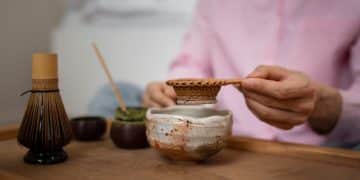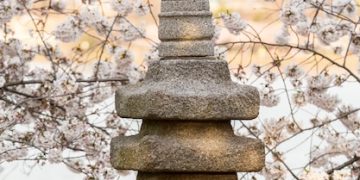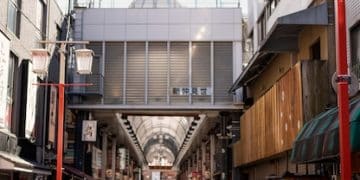Tea Ceremony Etiquette: US Guests Guide for Japan 2025
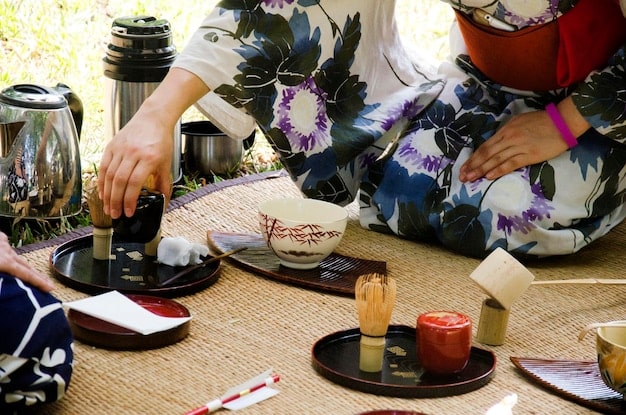
Navigating the serene world of the Japanese tea ceremony requires understanding. As a US guest preparing for 2025, knowing the specific etiquette ensures respect, appreciation, and a truly immersive cultural experience.
Embarking on a journey to Japan in 2025? Experiencing a traditional Japanese tea ceremony, or *chanoyu*, is a must. To make the most of this cultural experience, understanding the **tea ceremony etiquette for US guests in Japan: a step-by-step guide for 2025** is crucial. Proper etiquette demonstrates respect and enhances your appreciation of this time-honored tradition.
Understanding the Japanese Tea Ceremony
The Japanese tea ceremony is far more than just drinking tea. It’s a spiritual practice rooted in Zen Buddhism, emphasizing harmony, respect, purity, and tranquility. Before delving into the specifics, it’s beneficial to grasp the philosophical underpinnings that inform every aspect of the ritual.
These ceremonies aim to create a unique, shared experience between host and guests. Every element, from the choice of tea utensils to the seasonal sweets, is carefully curated to inspire mindfulness and aesthetic appreciation.
Four Principles of Chanoyu
The tea ceremony is guided by four key principles, which are often referred to as *wa-kei-sei-jaku*:
- Wa (Harmony): Emphasizes the importance of creating a peaceful and harmonious environment. This includes the relationship between the host and guests, as well as the setting of the tea room.
- Kei (Respect): Highlights the need to show respect for all participants, the tea utensils, and the natural world. Respect is demonstrated through specific gestures and behaviors.
- Sei (Purity): Encourages the purification of the mind and body. The tea room itself is meticulously cleaned to create a pristine space.
- Jaku (Tranquility): Promotes a state of calmness and serenity. The tea ceremony is a time to escape the stresses of daily life and find inner peace.
Understanding these principles will allow you to approach the experience with more sensitivity and awareness. It’s more than just following rules and involves understanding their deeper meaning.
In essence, the tea ceremony is a path towards inner peace and mutual understanding. By embracing its core values, US guests can fully immerse themselves in the ritual and establish meaningful connections with Japanese culture.
Preparing for Your Tea Ceremony
Proper preparation is key to respectfully experiencing a Japanese tea ceremony. This includes understanding what to wear, how to present yourself, and what to expect upon arrival. Planning ahead will reduce anxiety and ensure a more enjoyable experience.
Understanding what is expected of you demonstrates respect to your host and allows you to focus fully on the experience. A bit of pre-planning pays dividends in creating a richer, more meaningful immersion.
Attire and Appearance
Choosing appropriate attire demonstrates respect for the tradition. While formal wear isn’t necessary, modest and clean clothing is essential:
- Avoid overly revealing clothing, strong perfumes, and excessive jewelry.
- Opt for comfortable clothing that allows you to sit in *seiza* (kneeling position) for an extended period.
- Wear clean socks, as you will be removing your shoes.
The goal is to blend in respectfully and avoid distractions. Simplicity and cleanliness are valued more than elaborate fashion.
Mental Preparation
The tea ceremony is meant to be a meditative experience. Approaching it with the right mindset will enhance your appreciation:
- Leave your worries and distractions behind.
- Be open to new experiences and willing to learn.
- Focus on being present in the moment and appreciating the beauty of the ritual.
Cultivate a sense of mindfulness and receptivity. The tea ceremony offers a chance to step back from the chaos of daily life and embrace tranquility.
Preparation is an intentional act of respect. By taking the time to consider these aspects, you position yourself to participate meaningfully in the **tea ceremony etiquette for US guests in Japan: a step-by-step guide for 2025**.
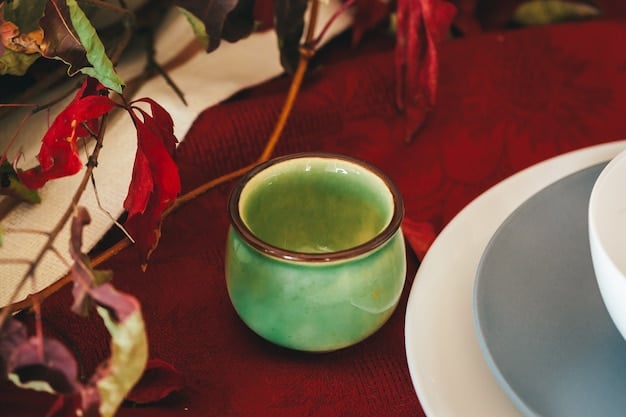
Step-by-Step Guide: Entering the Tea Room
Entering the tea room, or *chashitsu*, involves specific protocols designed to foster humility and mindfulness. Every movement is deliberate, contributing to the overall sense of tranquility and respect.
Familiarizing yourself with these entry procedures will help you navigate the beginning of the ceremony gracefully. It demonstrates a willingness to embrace Japanese customs.
Upon arrival at the tea room, you will typically be greeted by the host. They will guide you through the following steps:
- Remove your shoes at the entrance and place them neatly facing outwards.
- Step onto the *tatami* mats in your socks.
- If there’s a designated entrance (*nijiriguchi*, a small, low entrance), crouch down to enter. This symbolizes humility.
- Move towards your designated seating area, usually indicated by cushions (*zabuton*).
Understanding these steps helps you enter the tea room with respect and grace, setting the tone for the ceremony.
Seating Etiquette: Seiza Position
The traditional seating position in a tea ceremony is *seiza*, which involves kneeling with your legs folded underneath you. It can be challenging for those not accustomed to it:
- If you have difficulty sitting *seiza*, don’t hesitate to adjust your position discreetly.
- It is also acceptable to sit cross-legged if necessary. Just inform the host beforehand.
Comfort is important, but so is maintaining a respectful posture. Communicate respectfully if you need an adjustment.
Mastering the entry sequence provides a sense of confidence. By being aware of these details of the **tea ceremony etiquette for US guests in Japan: a step-by-step guide for 2025**, a greater appreciation of the ceremony begins.
Receiving and Enjoying the Tea
The heart of the tea ceremony is, of course, the tea itself. Receiving and consuming the tea involves specific gestures and actions that convey respect and appreciation for the host and the tea.
Being mindful of these steps allows you to fully engage with the flavor and aroma of the tea, making it a multisensory and spiritual experience.
When the host presents the tea bowl (*chawan*), follow these steps:
- Receive the bowl with both hands.
- Bow slightly to show gratitude.
- Rotate the bowl clockwise about 90 degrees to avoid drinking from the front (the most decorated part).
- Take a sip and appreciate the flavor.
- After taking a few sips, wipe the rim of the bowl with your fingers and discreetly clean them with a *kaishi* (paper napkin).
- Admire the bowl before returning it to the host.
These actions demonstrate respect for both the tea and the tea master.
Understanding Tea Flavors
The tea served in a tea ceremony is typically *matcha*, a finely ground green tea powder. The flavor can be intense and slightly bitter. Consider these elements:
- Savor the aroma and the color of the tea.
- The bitterness of the *matcha* is often balanced by a small sweet (*wagashi*).
- Take your time and enjoy the experience.
The tea is more than liquid, more than a taste. It is an experience to savor.
Immersing yourself in the taste and process elevates the tea ceremony to a level of true zenful appreciation. By honoring these steps in this **tea ceremony etiquette for US guests in Japan: a step-by-step guide for 2025**, you enhance your cultural immersion within Japan.
Communicating During the Ceremony
Verbal and non-verbal communication plays a crucial role in the tea ceremony. Knowing when to speak and how to express yourself is essential for a positive interaction.
Navigating these communication nuances subtly highlights your regard for the ritual, while still creating a welcoming and easy setting for yourself.
Verbal Communication
During the ceremony, conversation is kept to a minimum to maintain a sense of tranquility. However, there are certain phrases you can use to show appreciation:
- When receiving tea or sweets: “*Otemae choudai itashimasu*” (I will gratefully receive).
- After finishing the tea: “*Gochisousama deshita*” (Thank you for the delicious tea).
Simple, yet respectful language enhances your demonstration of gratitude.
Non-Verbal Communication
Non-verbal cues are just as important as spoken words:
- Maintain eye contact with the host to show attentiveness.
- Nod to acknowledge instructions or gestures.
- Express admiration for the tea utensils through subtle gestures.
Engage physically, as well as verbally, to show your mindfulness and respect.

Communication transcends words. By mastering these finer details covered in this **tea ceremony etiquette for US guests in Japan: a step-by-step guide for 2025**, you add to Japanese culture and etiquette.
Exiting the Tea Room
The departure from the tea room is as choreographed as the arrival. Maintaining grace and respect as you leave ensures a lasting positive impression.
By mirroring the same care for the exit, you reinforce your acknowledgement of the full cycle within the ceremony.
When the ceremony concludes, follow these steps:
- Express your gratitude to the host with a final bow.
- Stand up and turn to face the other guests, offering a slight bow.
- Exit the tea room gracefully, taking care not to step on the threshold.
- Retrieve your shoes and put them on facing away from the entrance.
These protocols demonstrate a continued mindfulness beyond the formal act of tea engagement.
Final Gratitude
A final expression of thanks is always appreciated:
Once outside, thank the host again for their hospitality.
Expressing a continued gratitude is a final way of showing thanks for the opportunity to be part of the tea ceremony.
A respectful, thoughtful departure caps off the **tea ceremony etiquette for US guests in Japan: a step-by-step guide for 2025**. This is a lasting and memorable way to engage in Japanese culture.
Additional Tips and Considerations
While the above sections covered the basic etiquette, there are additional tips and considerations that can further enhance your experience.
Paying attention to these finer details demonstrates a profound appreciation for Japanese culture well beyond the specific tea ceremony.
Seasonal Variations
The tea ceremony is deeply connected to the seasons. The choice of tea utensils, sweets, and decorations will vary depending on the time of year:
- Be aware of the seasonal theme and appreciate the subtle nuances.
- Ask the host about the significance of the seasonal elements if you are curious.
Every element in the tea room works with the seasons.
Dealing with Unforeseen Circumstances
Sometimes, unexpected situations can arise. Knowing how to handle them with grace is important:
- If you need to cough or sneeze, cover your mouth and turn away from the host and other guests.
- If you accidentally spill tea, apologize quietly and clean it up with the *kaishi*.
It is important to remain calm in the event of an occurrence.
Understanding these details and being receptive to learning helps enhance your experience within a **tea ceremony etiquette for US guests in Japan: a step-by-step guide for 2025**.
| Key Point | Brief Description |
|---|---|
| 🍵 Understanding Wa Kei Sei Jaku | The core principles of harmony, respect, purity, and tranquility governing the ceremony. |
| 👘 Proper Attire | Wear modest, clean clothing, and clean socks, avoiding strong perfumes and excessive jewelry. |
| 🙏 Receiving the Tea Bowl | Receive with both hands, bow, rotate the bowl, take a sip, wipe the rim, and admire before returning. |
| 🗣️ Communication | Use respectful phrases, maintain eye contact, and acknowledge gestures to show attentiveness. |
Frequently Asked Questions
▼
Practice sitting in seiza for short periods leading up to the ceremony. Use a small cushion or folded towel under your ankles to ease discomfort. If needed, discreetly adjust your position during the ceremony or ask the host for assistance.
▼
It’s considered impolite to refuse the tea. Take at least a few sips to show respect. If you truly cannot drink it, discreetly inform the host of any allergies or health concerns beforehand. They can offer an alternative.
▼
Observe the host and other guests carefully. Follow their lead and try to emulate their actions. Don’t hesitate to ask the host for clarification if needed. They will appreciate your interest in understanding the ritual.
▼
Avoid discussing controversial or negative topics, such as politics, religion, or personal problems. Focus on appreciating the tea, the surroundings, and the shared experience. Keep the conversation light and respectful to maintain the serene atmosphere.
▼
It is recommended to reserve your attendance to a tea ceremony as early as possible. Some tea rooms, especially those in popular tourist areas, can be booked weeks or even months in advance. Making reservations early ensures your participation.
Conclusion
Attending a Japanese tea ceremony in 2025 promises to be a unique and unforgettable experience. By understanding and practicing the **tea ceremony etiquette for US guests in Japan: a step-by-step guide for 2025**, you will not only show respect for this ancient tradition but also deepen your appreciation of Japanese culture. Preparation, mindfulness, and a willingness to learn are your greatest allies in navigating this serene and meaningful ritual.
